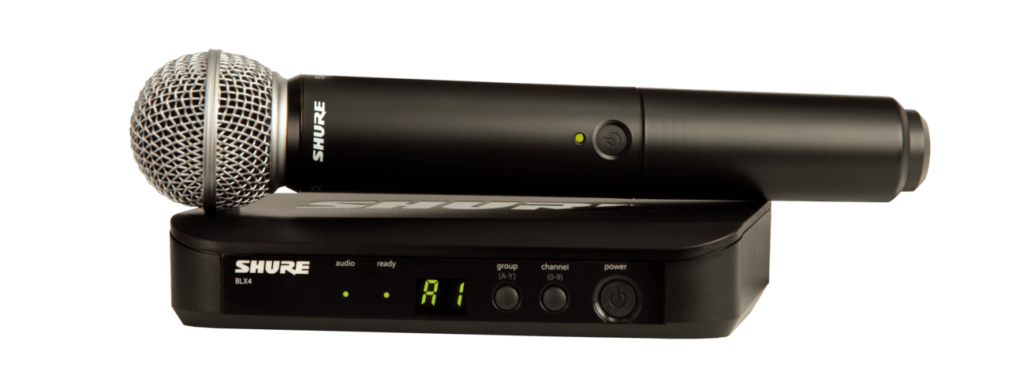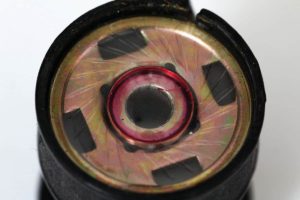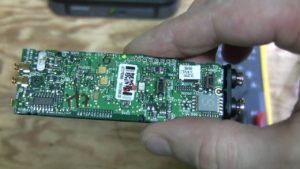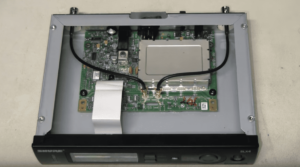
Wireless microphones are remarkable pieces of technology. They provide lots of freedom in the stage because there is no cable between the mic and the mixer. As with everything, they have their advantages and disadvantages.
How does a wireless microphone work? In simple terms, a wireless mic is almost the same as wired ones in the sense that it has the same components to pick up sound, but instead of having a wire going from the mic to the PA system, it uses radio waves to send the signal through the air to a receiver. Then the receiver extracts the audio signal to be amplified.
The explanation above is a straightforward one. In this post, I will go a bit deeper to explain each step in more detail so that you have a better understanding of how it works.
Parts that Make Up a Wireless Microphone
Any wireless microphone, regardless of the brand or model, is composed of three main parts: the transducer, also called a capsule or diaphragm, the transmitter, and the receiver. Let’s explore each one in more detail.
The Transducer or Capsule of the Microphone Section

The transducer or capsule is what converts sound into electrical signals. There are different types of microphone capsules, but the most common are dynamic, condenser, ribbon, and piezoelectric. Each one works somewhat differently, but the principle is the same.
For example, a dynamic capsule uses a very sensitive membrane material that is attached to a coil. The coil is carefully placed inside a magnet, usually a neodymium magnet. When sound hits the membrane, it vibrates.
The movement of the membrane also moves the coil. As the coil moves inside the magnet, a small current is created, which produces an electrical signal that contains the sound.
The electrical signal produced by the capsule then goes to a circuit that conditions the signal so that the transmitter can change it into radio waves to be broadcasted across the room to the receiver.
The Microphone’s Transmitter

After the electric signal is generated by the microphone’s capsule, and the signal is amplified to a point where the transmitter can use it, it goes to the next circuit, which is the transmitter.
Most modern wireless microphones use wideband FM modulation transmitters. More advanced or professional units use digital modulation so that the signal is secured from unauthorized reception.
In simple words, as explained in the website, searchnetworking.techtarget.com modulation is the process of converting any signal into radio waves, by adding the source signal to a carrier signal.
To achieve this, the carrier waveform must be a steady waveform, meaning that is has a constant frequency. The information, in our case, the electrical signal generated by the capsule, can be added to the carrier by varying the frequency of the carrier.
Wireless microphone transmitters are usually VHF (Very High Frequency) or UHF (Ultra High Frequency). And the frequencies of operation are 900MHz, 2.4GHz, and 6GHz.
The transmitter uses an antenna that can be seen on the outside of the microphones, at the bottom, or it could be inside. Most newer models have the antenna inside, so that is not seen.
For a transmitter to work, it needs electrical energy. The electrical power is supplied by the batteries that the user installs.
Professional wireless microphones have several channels or frequencies to choose from in case there is interference. Some models automatically scan the frequency spectrum to find available frequencies so that there is no interference from other wireless devices.
The Microphone’s Receiver

As the signal is modulated and converted to radio waves, it propagates in the atmosphere. The receiver has antennas that pick up the radio waves and, through electronic processes, demodulates the radio frequency to extract the original or source signal produced by the mic’s capsule.
In this post, I will not explain the demodulation process in detail because it’s beyond the scope of this article. But to explain it in simple words, the receiver is tuned to the same frequency as the carrier signal, and by using specially designed filters, the original signal is extracted, amplified, and sent to the output of the receiver.
The output of the receiver is then connected to a mixer or powered speaker, and that’s how a wireless microphone works.
Advantages of Wireless Microphones
- They don’t use wires, which means more freedom to move around in stage.
- By having fewer wires on stage, the number of trip hazards in significantly reduced.
- Using wireless mics eliminates hum noises called ground loops that can happen between wired microphones and instruments on stage.
Disadvantages of Wireless Microphones
- Wireless mics need batteries to work, and in some cases, they don’t last too long. Modern, professional wireless mics can work from 6 to 10 hours per battery change.
- There could be interference from other wireless equipment in the area.
- There could be some dead spots where the signal is lost, and thus the audio signal is lost as well. This is why it is essential to have a True Diversity Receiver System.
- Professional wireless microphone systems tend to be expensive. They can run in the hundreds or even thousands of dollars.
Things to Look for When Buying a Wireless Microphone System
I highly recommend buying a system that is UHF. The reason is that there are some VHF frequencies that the FCC is repurposing. By July of 2020, all systems using those frequencies must cease operations.
Buying a system on the UHF spectrum will save you from having the problem of your system becoming useless. To learn all about the frequency changes, read this post about what wireless microphone frequencies are legal.
Another recommendation is to buy a True Diversity Wireless Microphone System. A true diversity system has a receiver that uses two separate antennas located at opposite sides connected to two different receivers.
Internally a processor checks to see which antenna has the stronger signal, and depending on the signal strength, it switches back and forth between the two antennas. This method significantly reduces signal dropout.
Make sure to buy a wireless microphone system that offers the longest time between battery changes or charges. I recommend getting a battery charger and enough rechargeable batteries because the cost of buying regular alkaline batteries will add up.
If possible, stick with well-known brands such as Shure, Sennheiser, AKG, Audio Technica, Rode, etc. because their products will be of high quality and reliable. And believe me, you don’t want to buy a cheap wireless mic system, they are just not worth the trouble, I tell you this from experience.
Final Thoughts
I hope that this article helped you better understand how does a wireless microphone work. In case you are looking to buy a wireless mic system, follow the recommendations explained in this post, it will help you make a better choice.
For questions about this or any other post in this blog, please leave a comment or use the contact us form and I will get back to you within a few days. Thank you for reading my blog.